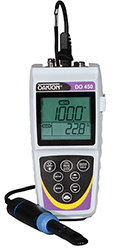How Optical Dissolved Oxygen Meters Work
Convenience and accuracy? With no membrane replacement, no electrolyte replacement, no incoming flow required, and no hydrogen sulfide interference, optical dissolved oxygen portable meters are winning over fans. The meters also offer a short response time, minimal drift, and minimal maintenance.

Oakton® Waterproof DO 450 Meter with Probe with Calibration
Optical technology developed from the principle that dissolved oxygen quenches the luminescence associated with chemical dyes in the sensor. The probe measures dissolved oxygen by emitting a blue light that causes the sensing element to luminesce or glow red. When no oxygen is present, the luminescence signal is at its maximum. As oxygen is introduced, luminescence decreases.
Three ways of measuring optical dissolved oxygen are:
- Magnitude domain measures the peak height of luminescence. Accuracy degrades over time as the sensor degrades due to photo-bleaching; frequent calibration is required for this method.
- Time domain measures the decay rate of luminescence. Signal-to-noise ratio can limit the sensor range in this method.
- Phase domain (phase detector) measures the phase difference based on the entire signal and reference wave forms across a population of pulses. This method delivers the highest accuracy over the widest operating range and is commonly used.
What are the limitations of optical dissolved oxygen meters? Exposure to alcohols and other organics must be limited to avoid damage to the sensor.

Comentarios
Publicar un comentario